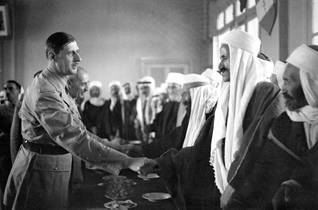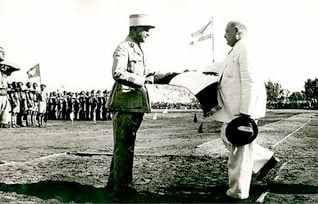Introduction
The outcome of World War I reshuffled the cards once again. Turkey lost all its territories, which were now held by the western allied forces, Great Britain and France. The latter had strongly hesitated about sending troops to the Levant, as it was fighting a war on its own western front.
Yet French – and North African – troops fought in Lebanon and in Syria, which had been within its sphere of influence for at least a century, in particular, because of the Jesuit missionaries in both countries. France’s ties with the Lebanese Maronites went back even further.

After the armistice on 30 October 1918, the former Turkish territories in the Levant were declared ‘occupied enemy territories’. Following the Sykes-Picot Agreement, concluded even before the war was ended (named after their negotiators, the British Mark Sykes and the Frenchman François Georges-Picot), the French occupied Lebanon, the coastal parts of Syria and Cilicia, the south-eastern Anatolian coast. The interior part of Syria, as well as Iraq, Palestine, and Transjordan, were held by the British.
Before the French took over, Lebanon and Syria were held by Emir Faysal, son of Husayn, Sharif of Mecca, whose troops, alongside those of the British Colonel T.E. Lawrence (Lawrence of Arabia), defeated the Turkish troops in the region. For a few days, Faysal – who had been promised the Kingdom of Greater Syria – had his flag hoisted in Damascus as well as in Beirut.
In Beirut, it was taken down when the British general Edmund Allenby and the French colonel Philipin de Piepape set foot in Lebanon. Faysal was invited, albeit begrudgingly, to the peace conference that was afterward held in Paris. France claimed the mandate over the whole of Syria as well as Lebanon, which it was accorded in the treaty signed in 1920.
The mandate over Palestine, Transjordan, and Iraq up to the Iranian border, went to the British. Cilicia was given back to Turkey, and as a consequence, thousands of Turkish Christians and Armenians who had survived the massacres of 1915-1916 and had taken refuge in Cilicia, fled to Lebanon.
Emir Faysal
Faysal was made King of Iraq, while his brother Abdullah became the first Emir of Transjordan, later King of Jordan. The latter’s descendants are still on the throne in Jordan. Faysal’s grandson, Faysal II, was murdered in 1958, during the coup that brought the Iraqi military to power.
Faysal’s influence was great. He revitalized the idea – already launched in the 17th century by Mount Lebanon’s Emir Fakhr al-Din – of an Arab state that would unite the whole region. Faysal’s ideas were met with distrust by the Christians in Lebanon and Syria; in their eyes, he did not make a clear distinction between the spiritual and worldly powers. There was confusion about whether Faysal’s proposed state would be Arab or rather Muslim. On the other hand, many Levantine Christians certainly did adhere to the idea of pan-Arabism, which had started to spread in the late 19th century and which was met with widespread enthusiasm throughout the Arab world in the 1920s and 1930s.
Under the French Mandate
Under the French mandate, Lebanon, so far restricted to the mountainous regions and – except for the previous half-century – the Beqaa Valley became Greater Lebanon, and was united with the coastal region. This meant a fundamental change in the composition of Lebanon’s population, the coastal cities being inhabited mainly by Sunni Muslims and Greek Orthodox.
The Druze became a very small minority in the country, making up a mere 6.8 percent, according to the 1932 census. The Maronites, still the largest group (28.8 percent) and by far the majority among the Christians (Greek Orthodox 9.7, Greek Catholic 5.9, other Christian denominations – mainly Armenian – 6.8 percent), did not dominate the social landscape as they had previously.
Together, the Christians remained in the majority: 51.2 percent. The Sunni at the time represented 22.4 percent of the population, the Shiites 20.3. Together with the Druze (6.8 percent), the Muslim community as a whole formed 49.7 percent of the population.
The new borders also meant that the country was formally independent in its relationship to Damascus. The mandate that the French received from the League of Nations was clear: Lebanon should eventually become an independent country, and France should help the Lebanese to realize this.
In the following years, the Lebanese started working on their Constitution, which was completed in 1926. It was this Constitution that stipulated that the President of the Republic was to be a Maronite Christian, while the Speaker of Parliament should be a Shiite and the Prime Minister a Sunni, while the Druze provided the Minister of Defence.
The parliamentary seats – and the constituencies – had to be divided among most of the eighteen recognized religious denominations. Within these restrictions, the Members of Parliament were elected on a political platform and as members of political parties or coalitions. The political spectrum stretched from the communist party on the left to the Phalange on the right.
Political ideas were largely discussed in the newspapers and the newspaper industry was thriving. Even in the early days of the French mandate, the Lebanese press enjoyed exceptional freedom in the Arab world, although it was not entirely free, as the French military were in power until 1926. Newspapers were distributed and read on a large scale, not only in the capital but also in regional towns, which often had their own local newspaper.
The Road to Independence
Independence was to be obtained step by step. It was finally achieved in 1943, in the midst of World War II. As soon as France was at war with Germany, in September 1939, the Lebanese Constitution was suspended and Parliament dissolved. The President, Émile Eddé, and the government had hardly any powers.
Late 1940, the then French High Commissioner, general Henri Dentz, representing the collaborating Vichy government of France, appointed Alfred Naccache as ‘Head of Government’. President Eddé abdicated shortly afterward when food shortages caused by the British blockade resulted in serious protests by the population.
In July 1941, Lebanon was liberated by British and Free French forces of general Charles De Gaulle, and the representatives of the Vichy government left for France.


But although independence had been promised both by the French and the British as soon as they entered Lebanon and Syria in June 1941, it took six months for the French in power to acknowledge this promise and to recognize Naccache as President of the Republic. It took almost two more years – and the victory of the Allied forces in the region – before the French allowed free elections and, in preparation thereof, the constitution of a provisional government.
In view of these elections the decision was made to distribute the parliamentary seats along the lines of the different religious communities, according to their share of the population, based on the census of 1932. Moreover, President Bechara al-Khoury (Maronite) and Prime Minister Riad al-Solh (Sunnite) drew up a (non-written) National Pact in which Muslims and Christians committed themselves to live peacefully together.
Muslims were to renounce a possible attachment of Lebanon to any pan-Arab nation, Christians to renounce the protection of western powers – mainly France or Great Britain at the time. This National Pact proved fundamental on Lebanon’s road to independence, as the western powers, France in particular, feared the rise of pan-Arabism in the region and its possible implications, such as calls for creating a Greater Syria. Though often criticized as carrying the seeds of later conflicts amongst the country’s communities, the Lebanese were loyal to this National Pact, which was to remain in place until the Taif Agreement of 1989.

